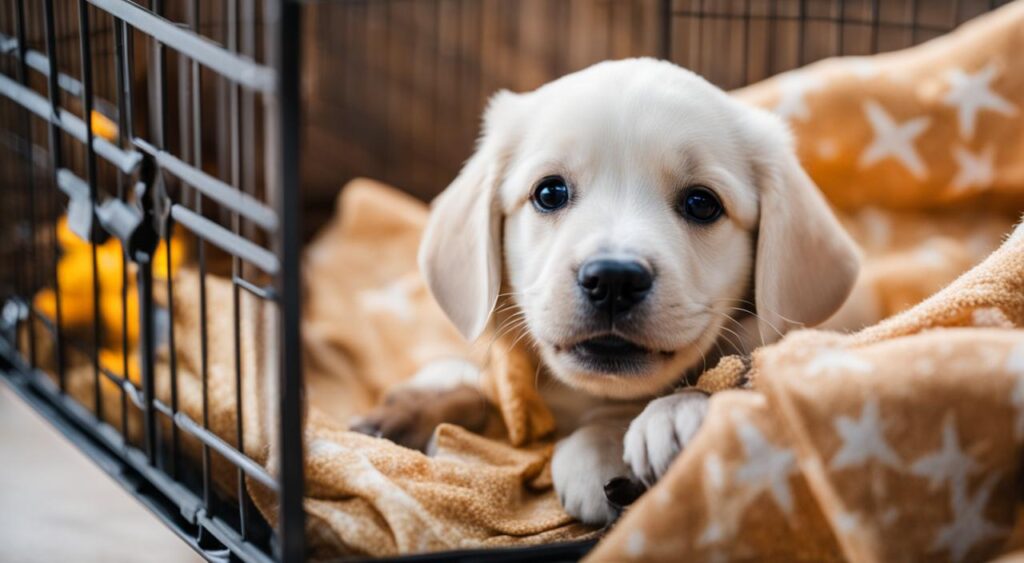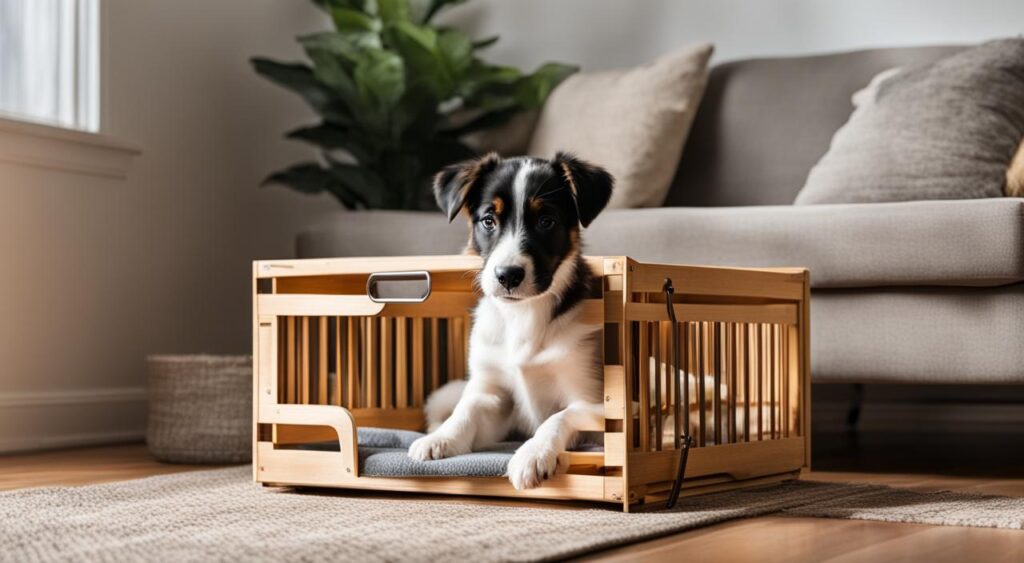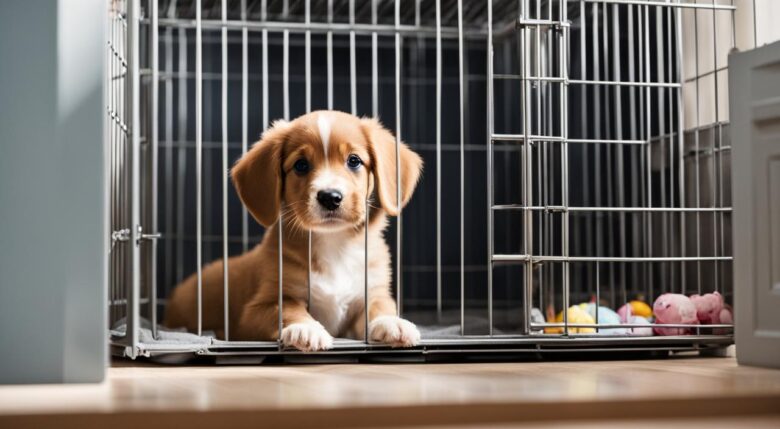Bringing home a new puppy can be an exciting time, but it also comes with its challenges. One of the biggest challenges is puppy crate training, a process that can help your furry friend become better-behaved and house-trained.
Crate training involves gradually introducing your puppy to a crate and teaching them to associate it with a safe and comfortable space, much like a den. But how do you ensure successful puppy crate training? In this article, we will provide essential tips for crate training a puppy, from getting started to overcoming challenges along the way.
Key Takeaways
- Crate training is an effective way to provide your puppy with a sense of security and help them become well-behaved and house-trained.
- Choose the right crate and gradually introduce your puppy to it to create a positive association.
- Establish a consistent crate training schedule and rely on positive reinforcement methods to encourage good behavior.
- Be patient and address any challenges that may arise, such as separation anxiety or crate aversion.
- Gradually transition your puppy to more freedom while maintaining the crate as a safe space.
Why Crate Training is Important for Puppies
Crate training is an essential part of raising a well-behaved and house-trained puppy. Not only can it provide a safe and comfortable space for your puppy to rest and relax, but it also offers numerous other benefits.
- Crate training can aid in potty training, as puppies are less likely to soil their sleeping area and learn to hold their bladder for longer periods of time.
- It promotes positive chewing behaviors. Puppies have a natural urge to chew, and a crate filled with appropriate toys and chews can help satisfy this urge and prevent destructive chewing on household items.
- Crate training can reduce separation anxiety and stress, as puppies become accustomed to being alone and learn to enjoy their crate as a safe space.
- It provides a sense of security and comfort for your puppy, particularly during times of stress or uncertainty, such as during car rides or vet visits.
When beginning your puppy’s crate training, be sure to start with the basics. Choose a crate that is appropriately sized for your puppy, and introduce them to it gradually with positive reinforcement and treats. With consistency and patience, your puppy will come to love their crate and all the benefits it provides.
Getting Started with Crate Training
If you’re a new puppy owner, crate training can feel a little overwhelming. But don’t worry, with these helpful tips, you can get started on the right paw!
Choosing the Right Crate
When selecting a crate, make sure it’s the appropriate size for your puppy. It should be large enough for them to stand up, turn around, and lie down comfortably but not so large that they can use one end as a bathroom. Consider a wire or plastic crate that’s easy to clean and has good ventilation.

Introducing Your Puppy to the Crate
Once you have your crate, introduce your puppy to it slowly. Start by placing treats and toys just inside the crate to encourage them to explore. Once they’re comfortable, feed them near the crate and gradually move their food inside. Remember to keep the door open during these early stages.
Pro Tip: Never force your puppy into the crate or use it as punishment. The crate should always be a positive and safe space for your furry friend.
Creating a Positive Association
As your puppy becomes more comfortable with the crate, start closing the door for short periods while remaining in the room. Gradually increase the time and distance you leave them alone in the crate. Offer praise, treats, and toys when they’re quiet and calm. This positive reinforcement will help them associate the crate with good feelings and make crate training a success.
Establishing a Crate Training Schedule
When it comes to crate training, consistency is key to success. Establishing a schedule will help your puppy learn when it’s time to rest and when it’s time to play. It’s essential to follow your puppy’s natural rhythm, taking into account their feeding and sleeping times.
Start by gradually increasing crate time, making sure not to force your puppy to stay inside for extended periods. As a general rule, a puppy can stay inside a crate for one hour per month of age, plus one hour, up to a maximum of eight hours. For example, if your puppy is three months old, they can stay inside the crate for up to four hours.
Crate Training Schedule
| Time of Day | Activity |
|---|---|
| 7:00 AM | Wake up, take puppy out to potty, offer breakfast |
| 8:00 AM – 10:00 AM | Playtime, training, and socialization |
| 10:00 AM – 12:00 PM | Crate time (2 hours) |
| 12:00 PM | Take puppy out to potty, offer lunch |
| 1:00 PM – 3:00 PM | Playtime, training, and socialization |
| 3:00 PM – 5:00 PM | Crate time (2 hours) |
| 5:00 PM | Take puppy out to potty and provide dinner |
| 6:00 PM – 8:00 PM | Playtime, training, and socialization |
| 8:00 PM – 10:00 PM | Crate time (2 hours) |
| 10:00 PM – 7:00 AM | Nightly sleep in the crate |
You can adjust the schedule as necessary to fit your lifestyle, but remember to maintain a consistent routine. It’s also important to use positive reinforcement during crate training, rewarding your puppy when they enter and exit the crate voluntarily and praising them when they stay inside calmly.
Positive Reinforcement in Crate Training
While crate training can be an effective technique to help your puppy become house-trained and well-behaved, it’s important to use positive reinforcement and reward good behavior. This will create a positive association with the crate and make training more effective in the long run.
One effective crate training method is to gradually increase the time your puppy spends in the crate. Start with short periods of time, such as 10-15 minutes, and gradually build up to longer periods. You can use praise, treats, or toys to reward your puppy for calm and quiet behavior in the crate.
It’s also important to create a consistent routine for crate training. Use the crate at night and during the day when you are away, and ensure that your puppy has plenty of exercise and playtime outside of the crate. This will help your puppy learn to associate the crate with relaxation and restful sleep, rather than boredom or confinement.
To make crate training more enjoyable for your puppy, consider including comfortable bedding and toys inside the crate. You can also use verbal cues, such as “crate” or “go to bed,” to signal to your puppy that it’s time to enter the crate.
Positive Reinforcement Techniques:
| Technique | Description |
|---|---|
| Clicker Training | Using a clicker to signal good behavior and providing a reward immediately afterwards |
| Verbal Praise | Using positive words such as “good job” or “well done” to reward good behavior |
| Treats | Providing small, healthy treats to reward good behavior such as entering or staying in the crate calmly |
By using positive reinforcement techniques and gradually increasing crate time, your puppy can learn to view the crate as a safe and comfortable space. Remember that consistency and patience are key to successful crate training!
Overcoming Crate Training Challenges
While crate training can be an effective method for teaching your puppy to be well-behaved and house-trained, there may be challenges you face along the way. Two of the most common issues are separation anxiety and crate aversion.
Separation Anxiety
Some puppies may become anxious or distressed when left alone in their crate, even for short periods. To help your puppy overcome separation anxiety during crate training, it’s important to:
- Start crate training slowly and gradually increase the amount of time your puppy spends in the crate.
- Introduce your puppy to the crate with positive reinforcement, such as treats, toys, and praise.
- Make sure your puppy has plenty of exercise and playtime before being placed in the crate.
- Provide your puppy with a comfortable and cozy environment in the crate, including a soft bed and familiar toys.
- Avoid reinforcing anxious behavior, such as whining or barking, by not rewarding it with attention.
Crate Aversion
Some puppies may develop an aversion to their crate, making it challenging to continue with crate training. To help your puppy overcome crate aversion, try:
- Making the crate more comfortable and inviting with plush bedding and toys
- Placing treats and food inside the crate to encourage your puppy to go in on their own
- Playing calming music or leaving a familiar blanket or item of clothing with your scent on it inside the crate
- Avoiding using the crate as punishment and keeping training sessions positive and rewarding
Remember, crate training is not always a one-size-fits-all approach and it may take time and patience to find the right methods and routines that work for you and your puppy.
Gradual Transition to Freedom
After your puppy has become comfortable spending time in their crate, it’s time to start the gradual transition to freedom. This step should be done slowly and supervised to avoid any accidents or destructive behavior.
Start by opening the crate door while your puppy is inside and allowing them to come out on their own. Don’t force them to come out, as this can create anxiety and reluctance to enter the crate in the future. Encourage them to come out with a treat or toy and offer praise.
Once your puppy is comfortable coming out of the crate, you can start leaving the crate door open when you’re home and keeping an eye on them. This allows your puppy to explore their environment while still having the option to retreat to the safety of their crate when needed.
As your puppy becomes more confident and well-behaved, you can gradually increase the amount of time they spend out of the crate. Start with short periods of 15-30 minutes and gradually work your way up to an hour or more.
Always supervise your puppy during this transition period to ensure they’re behaving appropriately and not getting into anything they shouldn’t. If you notice your puppy getting into trouble, it may be a sign that they need more time in the crate before they’re ready for more freedom.

In conclusion, the gradual transition to freedom is an important part of puppy crate training. With patience and consistency, you can help your puppy become a well-behaved and happy member of your household.
Conclusion
If you’re considering crate training a puppy, it’s important to keep in mind that this process can take time and patience. However, the benefits of crate training are numerous and well worth the effort.
By providing your puppy with a comfortable and secure space of their own, you’ll help them feel safe and relaxed in their new environment. Additionally, a well-trained and crate-trained puppy is much more likely to be well-behaved and house-trained, making life easier for both you and your furry friend.
Remember to choose the right crate for your puppy, and introduce crate training gradually, building up positive associations and reinforcing good behavior throughout the process. By establishing a consistent routine and using positive reinforcement techniques, you’ll be well on your way to successfully crate training your puppy.
Overall, crate training a puppy is an effective and humane way to promote good behavior and establish a strong bond with your pet. With the tips and techniques outlined in this article, you’ll be equipped to successfully crate train your puppy and enjoy a happy, healthy relationship for years to come.
So if you’re ready to start crate training your puppy, keep these tips in mind—good luck!
FAQ
Why is crate training important for puppies?
Crate training is crucial for puppies as it provides them with a safe and secure space, helps with house-training, prevents destructive behavior, and promotes good behavior and obedience.
How do I start crate training my puppy?
To start crate training, choose the right-sized crate, introduce your puppy to the crate gradually, make it comfortable with bedding and toys, and associate positive experiences with the crate.
What is the importance of establishing a crate training schedule?
Establishing a crate training schedule helps your puppy develop a routine, teaches bladder and bowel control, and ensures consistent training, leading to faster and more successful crate training.
What are some effective crate training methods?
Effective crate training methods include positive reinforcement, such as rewarding good behavior with treats and praise, using a command cue, and gradually increasing crate time to build comfort and confidence.
What challenges may arise during crate training and how can I overcome them?
Common crate training challenges include separation anxiety and crate aversion. To overcome them, gradually increase crate time, provide treats and toys for distraction, and seek professional help if needed.
How do I transition my puppy from crate confinement to more freedom?
Gradually transition your puppy to more freedom by increasing their supervised time outside the crate, setting up a safe puppy-proofed area, and ensuring they still have access to their crate as a comfortable space.




